GERMANY 2007
Day
5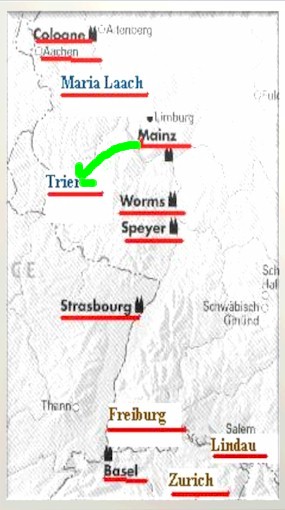
Saturday,
May 26
Mainz
to Trier
We
got up early and had breakfast in hotel dining room (not included in rate).
It was a buffet but not as good as the Cologne hotel.
It was very crowded, maybe from a tour group.
We shared a table with a man from Slovenia who was with IBM and had been
in Mainz for a week. He was going
home today.
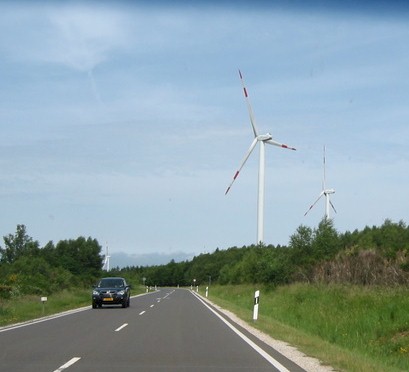
We
checked out and the TomTom zoomed in as soon as we got out of the garage.
It easily got us out of town even with a closed street.
We stopped for diesel. We
retraced some of our roads of yesterday. Then
we got on some two way roads but they weren’t bad. They had passing lanes
every once in a while. There were
some amazing wind mills along the road. We
ran into construction over a large hill. The
left lane was closed over the entire route.
Traffic in the opposite direction must have taken another route.
It went on for miles and miles.

TomTom
got us right to the Porta Nigra Mecur hotel door when it said it would - 11:49.
We checked in. The hotel is
directly across the street from the Porta Nigra, the ancient Roman gate.
We had a nice big room with a king size bed and two comfortable chairs.
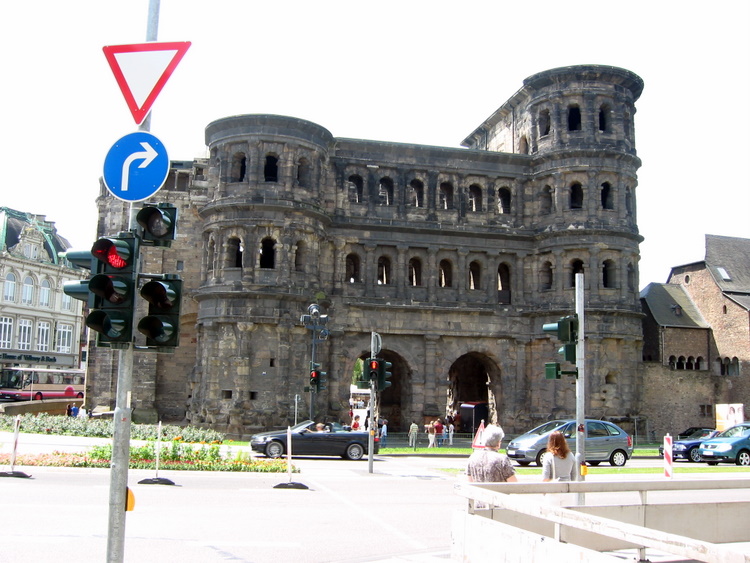
The
old city was right through the gate. Since
it was Saturday and a nice day, the streets were very crowded.
For lunch we found an outdoor café, there were a lot of them on the
street. I had Jaegerschizel and
french fries, and my better half had
a tuna salad. Both were good.
It took a long time to get our check.
This seems to be the custom. We s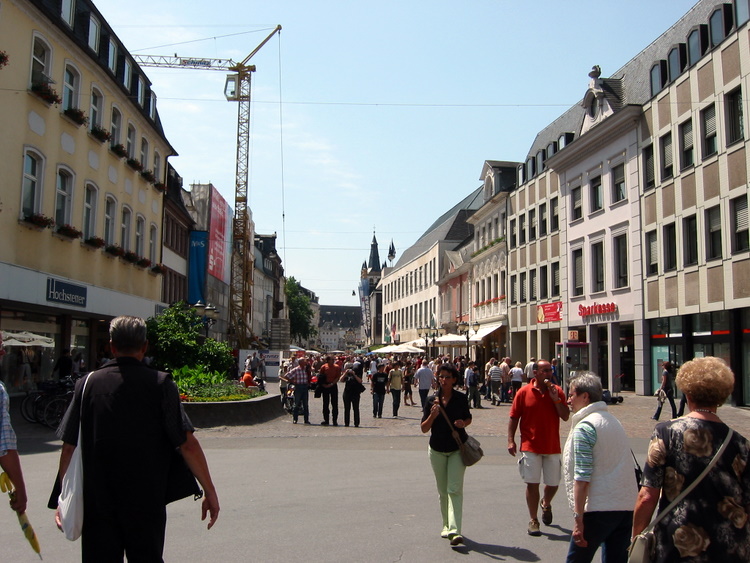 topped in a book store and got a couple
of guide books. Then we walked
through the old town to the Dom. The
Dom, which I will describe, was a
lot of different periods all in one, from Constantine in 325 to baroque.
topped in a book store and got a couple
of guide books. Then we walked
through the old town to the Dom. The
Dom, which I will describe, was a
lot of different periods all in one, from Constantine in 325 to baroque.
TRIER
Cathedral dates back to 326.
It is the oldest church north of the Alps which can claim a
continuous tradition of worship from the 4th century onward.
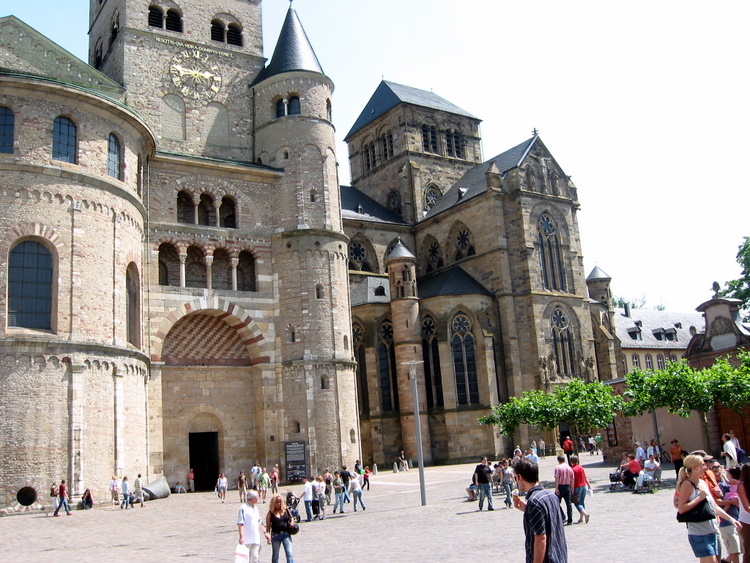
The cathedral church is part of
an unusual double church complex, consisting of the Cathedral and the
Church of Our Lady. The Lady church was constructed during reign of Constantine (306-337). Construction
of the cathedral began in 326 to celebrated 2nd anniversary of his reign.
Legend claims that St. Helena brought the Holy Robe of Christ from
Jerusalem to her son’s new church.
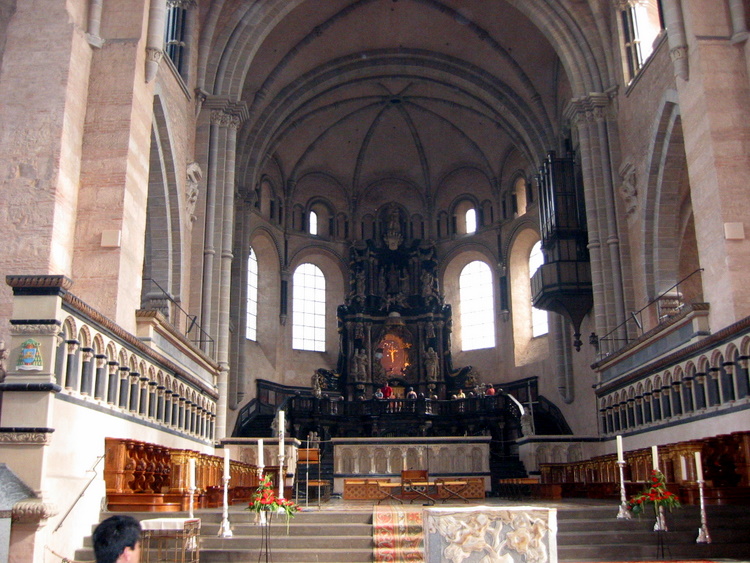
The
northern part of the present cathedral was expanded under Gratian (378-383).
The 82 foot walls still exists. In
the 5th century, the cathedral suffered various catastrophes from
invading Huns and Germanic tribes.
On
one occasion the building was completely gutted. It was not restored until mid 6th
century in same style. It was
severely damaged by Normans during Holy Week 882. During the last half of the 10th
century
restoration was started, but not completed.
Much
work went on in 12th & 13th centuries, but
Constantine’s huge dimensions continued to be retained.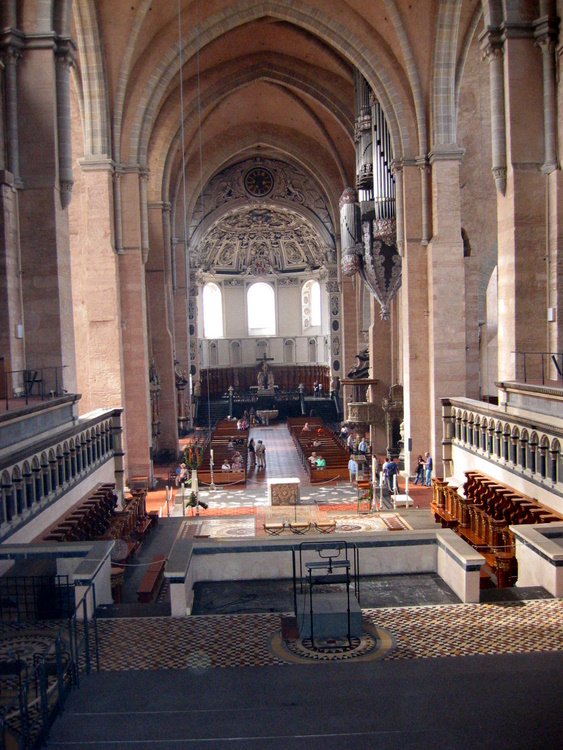
The ceiling vaulting is 13th
century Gothic. No work had been done on the cathedral for 200 years. The relic
chapel was built in1687. After a
fire in 1717, the
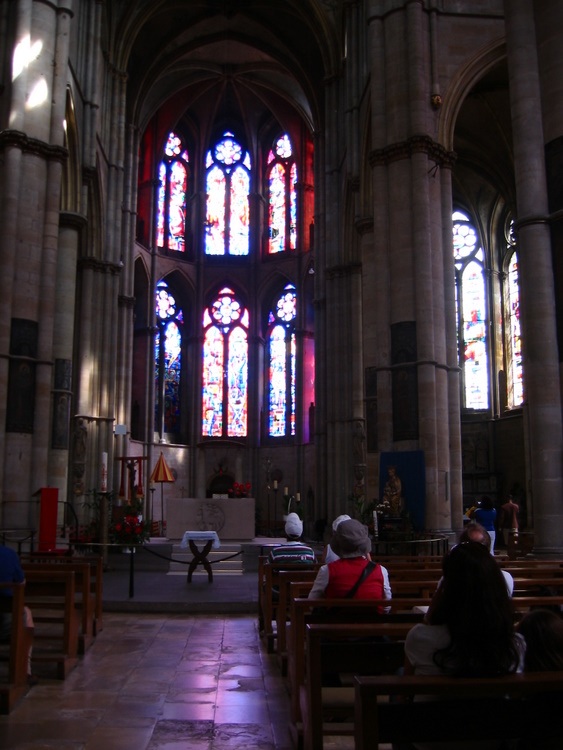 restorations were made in Baroque style. The 1900 renovation
gave rise to heated discussion. The
most recent restorations were 1960-1975.
There is only a small door on the right side for entrance into the cathedral,
unlike Gothic cathedrals with highly decorated facades and elaborate carvings
over the doors.
restorations were made in Baroque style. The 1900 renovation
gave rise to heated discussion. The
most recent restorations were 1960-1975.
There is only a small door on the right side for entrance into the cathedral,
unlike Gothic cathedrals with highly decorated facades and elaborate carvings
over the doors.
As
we experience in other German churches, Trier Cathedral has two apses - one at
each end. The eastern apse contains the altar, whereas the western was
reserved for royalty. The photo on the right was taken standing at the
high altar facing the west end of the church. The photo above on the left
is the ceiling in the western apse.
Next
to the Dom is Our Lady, Liebfraunenkircke,
one of the first German Gothic Churches. The
present church was built between 1230 and 1260.
It is in the shape of a G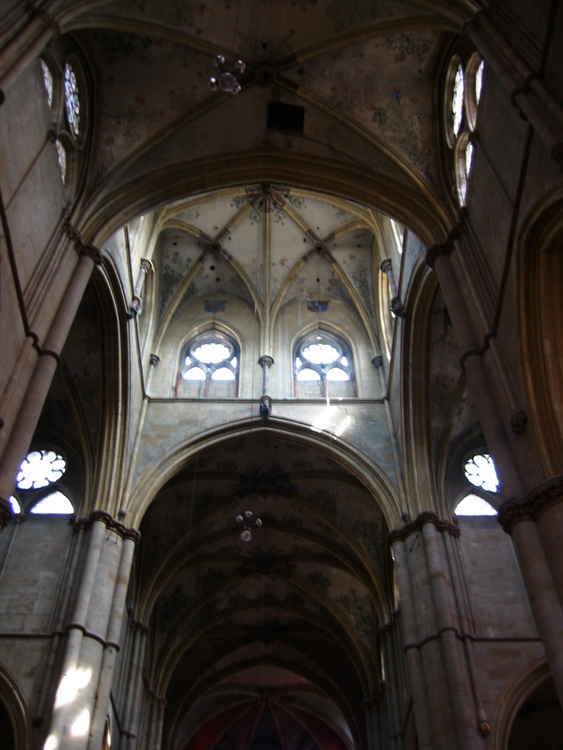 reek cross, creating a circular effect with all
points equidistant from the central high altar.
It is supported by 12 circular columns. The floor plan resembles a 12
pedaled rose, a symbol of Mary, the 12 tribes of Israel and 12 apostles.
The apostles and the 12 articles of Apostles’ Creed are painted on the
12 supporting columns. The design is
square at the crossing to which is connected the rectangular bays of the
transept arms and their 3 sided polygonal terminal wall.
reek cross, creating a circular effect with all
points equidistant from the central high altar.
It is supported by 12 circular columns. The floor plan resembles a 12
pedaled rose, a symbol of Mary, the 12 tribes of Israel and 12 apostles.
The apostles and the 12 articles of Apostles’ Creed are painted on the
12 supporting columns. The design is
square at the crossing to which is connected the rectangular bays of the
transept arms and their 3 sided polygonal terminal wall.
We
walked back to the hotel. My wife
was cold and had a cough. I went
back out to exchange a book which was in German.
I did a little more exploring and came back.
I got some ice. Ice is very
hard to get in hotels in Germany. There
are no ice machines in the halls. A
bad thunder storm came up so we decided to have dinner in the hotel restaurant.
It was attractive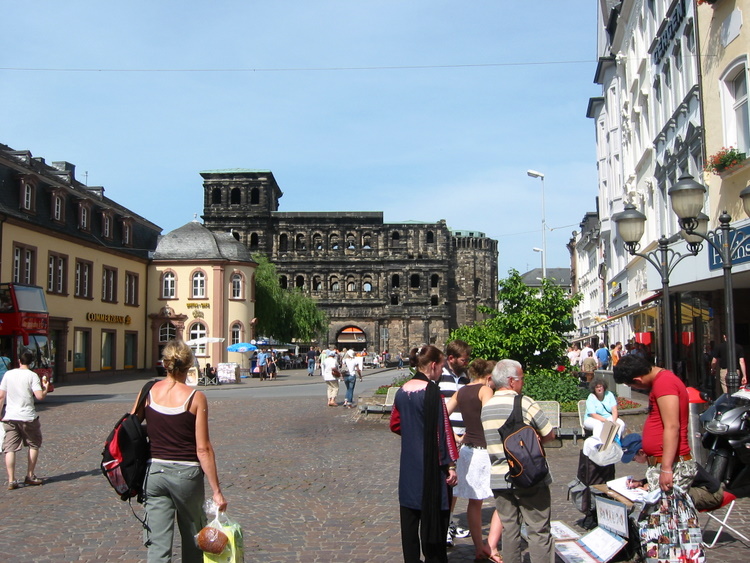 with a very nice buffet.
There were very few people there when we arrived and then all of a sudden
two large groups came in and filled up the room.
They were probably a tour group. The
food was good. We went back to room.
with a very nice buffet.
There were very few people there when we arrived and then all of a sudden
two large groups came in and filled up the room.
They were probably a tour group. The
food was good. We went back to room.







 topped in a book store and got a couple
of guide books. Then we walked
through the old town to the Dom. The
Dom, which I will describe, was a
lot of different periods all in one, from Constantine in 325 to baroque.
topped in a book store and got a couple
of guide books. Then we walked
through the old town to the Dom. The
Dom, which I will describe, was a
lot of different periods all in one, from Constantine in 325 to baroque.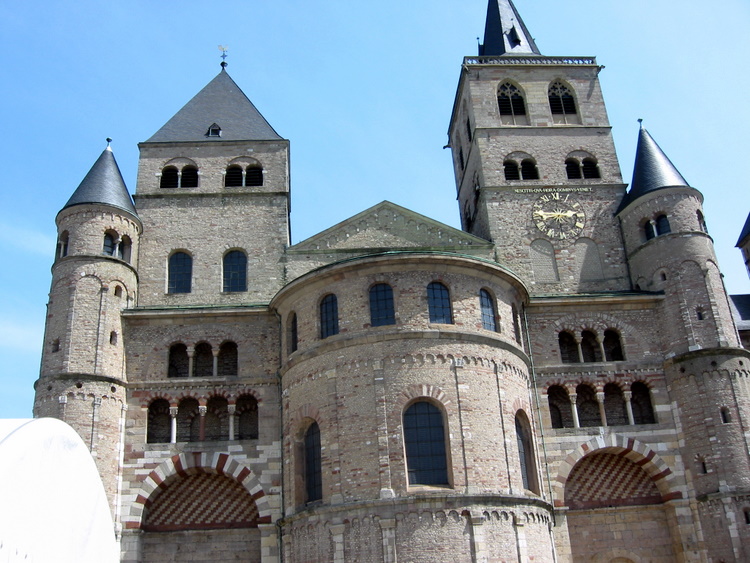





 restorations were made in Baroque style. The 1900 renovation
gave rise to heated discussion. The
most recent restorations were 1960-1975.
There is only a small door on the right side for entrance into the cathedral,
unlike Gothic cathedrals with highly decorated facades and elaborate carvings
over the doors.
restorations were made in Baroque style. The 1900 renovation
gave rise to heated discussion. The
most recent restorations were 1960-1975.
There is only a small door on the right side for entrance into the cathedral,
unlike Gothic cathedrals with highly decorated facades and elaborate carvings
over the doors.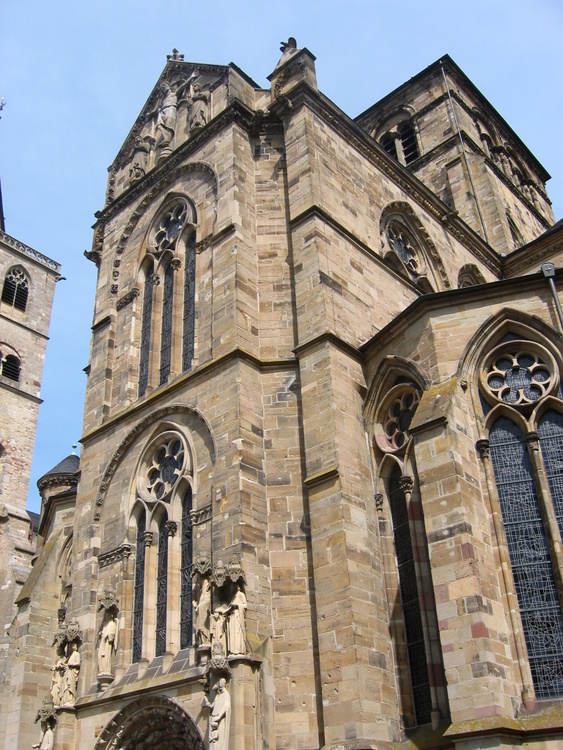 Liebfraunenkircke
Liebfraunenkircke reek cross, creating a circular effect with all
points equidistant from the central high altar.
It is supported by 12 circular columns. The floor plan resembles a 12
pedaled rose, a symbol of Mary, the 12 tribes of Israel and 12 apostles.
The apostles and the 12 articles of Apostles’ Creed are painted on the
12 supporting columns. The design is
square at the crossing to which is connected the rectangular bays of the
transept arms and their 3 sided polygonal terminal wall.
reek cross, creating a circular effect with all
points equidistant from the central high altar.
It is supported by 12 circular columns. The floor plan resembles a 12
pedaled rose, a symbol of Mary, the 12 tribes of Israel and 12 apostles.
The apostles and the 12 articles of Apostles’ Creed are painted on the
12 supporting columns. The design is
square at the crossing to which is connected the rectangular bays of the
transept arms and their 3 sided polygonal terminal wall. with a very nice buffet.
There were very few people there when we arrived and then all of a sudden
two large groups came in and filled up the room.
They were probably a tour group. The
food was good. We went back to room.
with a very nice buffet.
There were very few people there when we arrived and then all of a sudden
two large groups came in and filled up the room.
They were probably a tour group. The
food was good. We went back to room. restorations were made in Baroque style. The 1900 renovation
gave rise to heated discussion. The
most recent restorations were 1960-1975.
There is only a small door on the right side for entrance into the cathedral,
unlike Gothic cathedrals with highly decorated facades and elaborate carvings
over the doors.
restorations were made in Baroque style. The 1900 renovation
gave rise to heated discussion. The
most recent restorations were 1960-1975.
There is only a small door on the right side for entrance into the cathedral,
unlike Gothic cathedrals with highly decorated facades and elaborate carvings
over the doors. Liebfraunenkircke
Liebfraunenkircke reek cross, creating a circular effect with all
points equidistant from the central high altar.
It is supported by 12 circular columns. The floor plan resembles a 12
pedaled rose, a symbol of Mary, the 12 tribes of Israel and 12 apostles.
The apostles and the 12 articles of Apostles’ Creed are painted on the
12 supporting columns. The design is
square at the crossing to which is connected the rectangular bays of the
transept arms and their 3 sided polygonal terminal wall.
reek cross, creating a circular effect with all
points equidistant from the central high altar.
It is supported by 12 circular columns. The floor plan resembles a 12
pedaled rose, a symbol of Mary, the 12 tribes of Israel and 12 apostles.
The apostles and the 12 articles of Apostles’ Creed are painted on the
12 supporting columns. The design is
square at the crossing to which is connected the rectangular bays of the
transept arms and their 3 sided polygonal terminal wall. with a very nice buffet.
There were very few people there when we arrived and then all of a sudden
two large groups came in and filled up the room.
They were probably a tour group. The
food was good. We went back to room.
with a very nice buffet.
There were very few people there when we arrived and then all of a sudden
two large groups came in and filled up the room.
They were probably a tour group. The
food was good. We went back to room.